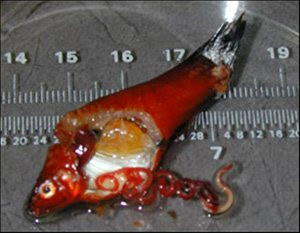
/156901898-56a81f0e3df78cf7729c582f.jpg)

Fortunately, these grubs aren’t harmful to humans as long as any affected fish are cooked properly. This is a common characteristic of fish parasites: starting and ending their life inside birds. Flukes use fish as a host, and then complete their lifecycle when the fish is eaten by another bird. If they survive, the grubs attach themselves to a fish either through ingestion or just being in close proximity to a fish (perch seem to be one of the most likely species to be infected by yellow grub, but there’s no hard data on that yet). The parasites form in birds and are then transferred to a snail (mollusk), where they can only live for a short time. Yellow, white, and black grubs are the most commonly found flukes (Trematodes) living in fish. Doing so could help prevent further outbreaks. (Note that many diseases look similar, and the only absolute way of determining the issue is through lab testing.) You should also photograph the fish and contact your state fish and wildlife agency to alert them. If you ever catch a suspicious-looking fish and you’re not sure what’s wrong with it, is a great resource to consult. (The Center for Disease Control and Prevention has outlined all the necessary precautions for tapeworms here.) Failing to do so risks a tapeworm infection. If you’re a connoisseur of ceviche or pickled fish, you definitely need to freeze the fish first. You can also treat the fish by throwing it in your freezer for a few days to kill any parasites. For the most part, parasites in fish cannot infect humans as long as the fish are cooked properly, which means heating it to an internal temperature of 145 degrees for 15 seconds. Every living organism is a host for parasites and susceptible to disease-and that includes fish.
#Freshwater fish parasite identification skin#
Have you ever seen black spots on the skin of a trout? Or small worms burrowed in the fillets of your crappie? How about a bass that has turned pale and is hardly able to swim? Spend enough time on the water, and you’ll eventually hook into an odd-looking fish.


 0 kommentar(er)
0 kommentar(er)
